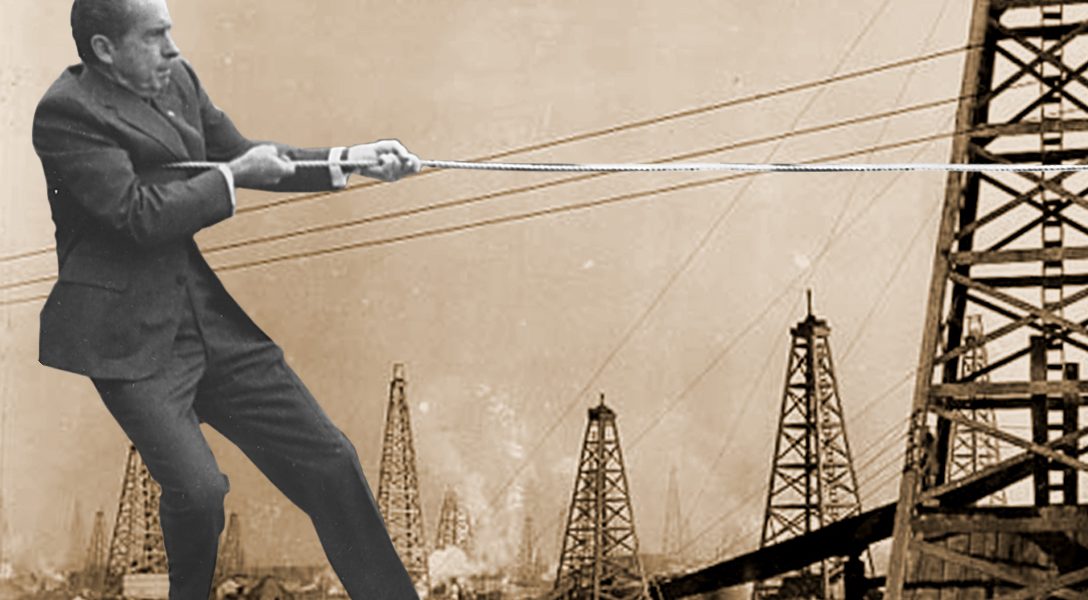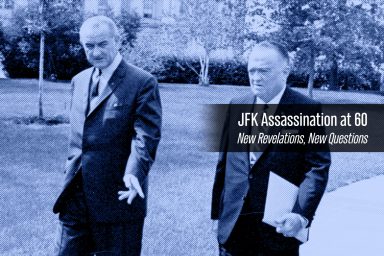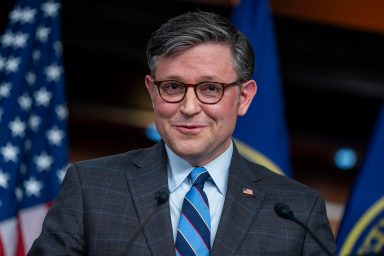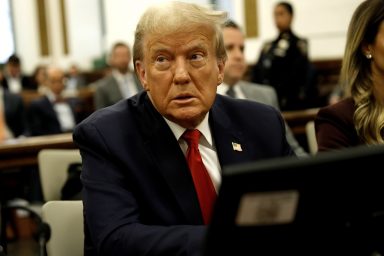More revealing details on the intricate ways in which President Richard Nixon clearly seems to have been set up. And the role of Big Oil behind some of the machinations — but who else was involved, and why?
We are running this series because people are looking to Watergate as a guide from another time, when another president was on the ropes. And we are running it because, as is often the case, the media did not truly investigate what went on, or why. They, along with many historians, continue to perpetuate basic falsehoods about what transpired during that epic scandal, while ignoring what Nixon actually did and said, as well as evidence suggesting that far different factors may have been behind his impeachment.
We recommend you start with Part 1. Here, in Part 3, we discover the possibility that oil played a role in Nixon’s demise. Isn’t it fascinating how oil seems to seep into everything everywhere? Many say JFK was killed, in part, because of his stand on the oil depletion allowance, a government program greatly benefiting oil companies. Oil issues certainly would cause massive problems for later presidents, including Gerald Ford and Jimmy Carter. Here, we examine how oilmen who had initially backed Nixon decided he was not so great after all. Then we look at an early precursor to Watergate — what seems like another scheme to pin something nefarious on Nixon, this one unsuccessful. Finally, we provide new details on the groundwork for and execution of Watergate — by a determined bunch with intelligence connections and a startling link to another set of events that led to another presidential transition:
“The most interesting thing was that the materials identified the burglars as connected not just to the White House, but to the CIA as well. And not just to the CIA, but to a group within the CIA that had been active during the controversial period that included the Bay of Pigs invasion and the assassination of JFK.”
For Part 1, go here; Part 2, here.
Excerpted from Russ Baker’s Family of Secrets: The Bush Dynasty, America’s Invisible Government and the Hidden History of the Last Fifty Years.
Notes: (1) Although these excerpts do not contain footnotes, the book itself is heavily footnoted and exhaustively sourced. (2) To distinguish between George Bush, father and son, George H.W. Bush is sometimes referred to by his nickname Poppy, and George W. Bush by his, W. (3) Additional context can be found in the preceding chapters.
Watergate’s Unknown Prelude
.
The series of scandals that undid Richard Nixon’s presidency are principally identified with the 1972 burglary at the Democratic party offices in the Watergate complex. But one could argue that Watergate — and Nixon’s Downfall — really began in late 1969, during Nixon’s first year in office, with a phone call from a man almost no one today has heard of.
An independent oilman named John M. King dialed in to offer ideas for improving Nixon’s hold over Congress. Former White House staffer Jack Gleason remembered the episode: “[King] called one day in ‘69 and said, ‘You know, we have to start planning for 1970.’ ”
King’s call suggested he was principally concerned about helping Nixon, but in retrospect, there may have been more at stake. For one thing, King was a member of the fraternity of independent oilmen who were growing increasingly unhappy with Nixon. As we saw in the last chapter, the oil barons were up in arms over threats to the oil depletion allowance, convinced that Nixon was not solidly enough in their corner. But they had other gripes. As Haldeman noted in a diary entry in December 1969:
“Big problem persists on oil import quotas. Have to make some decision, and can’t win. If we do what we should, and what the task force recommends, we’d apparently end up losing at least a couple of senate seats, including George Bush in Texas. Trying to figure out a way to duck the whole thing and shift it to Congress.”
On a more personal level, King was mired in problems. The Denver-based King had assembled a global empire with oil drilling and mining operations in a hundred countries; he was known for a high-flying lifestyle and a gift for leveraging connections. He even had two Apollo astronauts on his board. In 1968, King had donated $750,000 to Nixon, and as a big donor, his calls always got attention. But King was, according to a Time magazine article of the period, something of a huckster. By late 1969, his empire was on the verge of collapse. In the end, he would face jail and ruin.
Perhaps he was looking to secure intervention from the White House. Perhaps it was just general business insurance. Or perhaps he was speaking on behalf of his fellow independent oilmen.
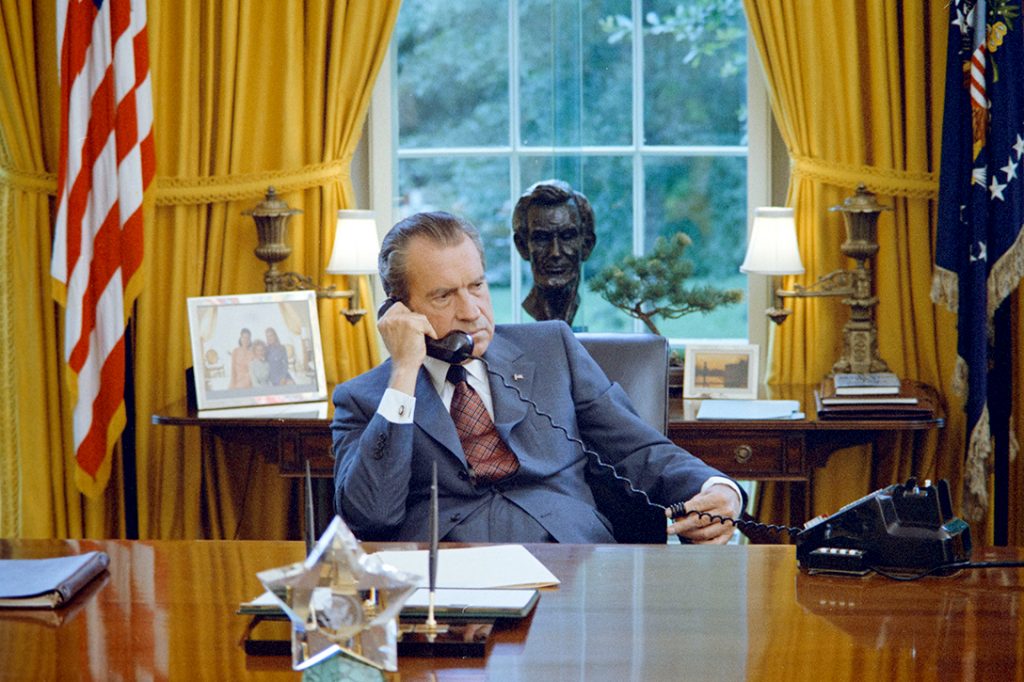
President Richard Nixon on the telephone at the Oval Office Desk, June 23, 1972. Photo credit: The White House / Nixon Library
In any event, King’s pitch sounded like a good idea. He was proposing that the Nixon White House funnel money from big GOP donors directly to Senate and House candidates of its choice, rather than following the customary method: letting the Republican Party determine the recipients. To do this without provoking the wrath of the GOP establishment, King suggested it be kept under wraps. This idea appealed to the White House brass, and soon, a special operation was being convened.
”As it matured, we had a couple of meetings with Ehrlichman and Haldeman and went over some of the ground rules,” said Gleason. Haldeman brought the bare bones of the idea to Nixon, who thought it sounded fine. Anything that involved secrecy and centralized White House control was likely to find a receptive ear. Gleason’s recollection is confirmed by a notation in Haldeman’s diary of December 11:
“I had meeting with [Maurice] Stans, Dent, and Gleason about setting up our own funding for backing the good candidates in hot races. A little tricky to handle outside the RNC but looks pretty good.”
The White House political unit assigned the job of organizing and running the new fund to its operative Gleason, an experienced GOP fundraiser. Gleason was instructed by his boss, Harry Dent, to find an office for the operation. When he suggested renting space in one of those pre-furnished office suites that come with secretarial and other services, he was told that this would be too expensive.
That struck Gleason as odd, since it would not have cost much more and would have been a pittance in relation to the large sums that would be raised. But he followed his orders and rented something cheaper and more discreet. Dent directed him to a townhouse on Nineteenth Street, in a residential area near Dupont Circle. The space was not just in a townhouse but in the basement of a townhouse. And not only that, it was in the back of the basement. Reporters would later describe it as a “townhouse basement back room” — an arrangement guaranteed to raise eyebrows if ever discovered.
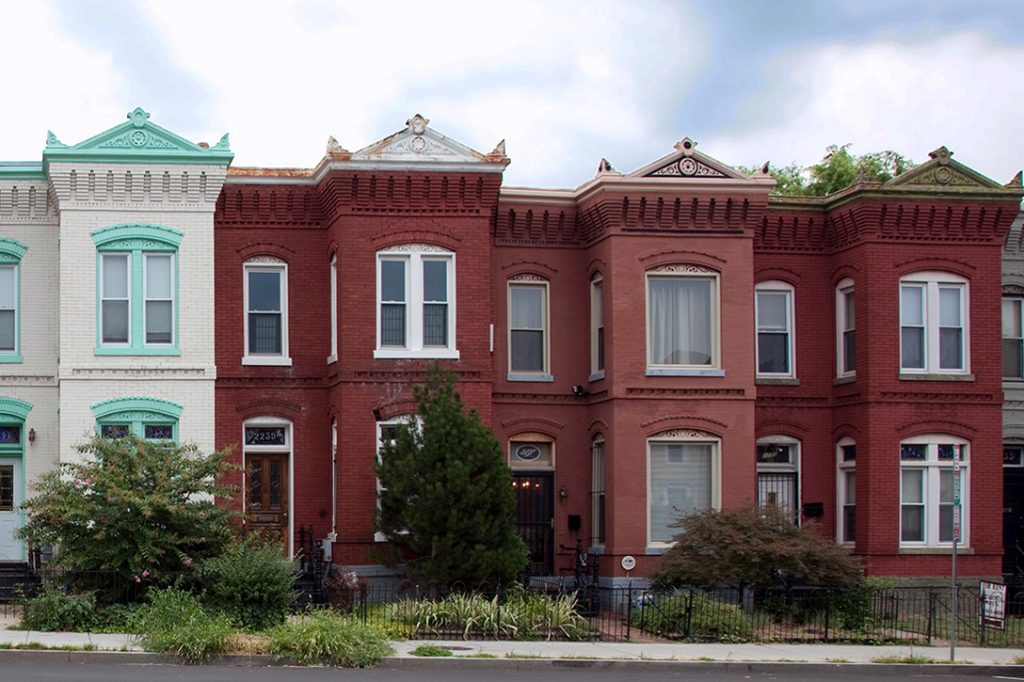
Townhouses in Washington, DC. Photo credit: Carol M. Highsmith / Wikimedia
The way in which the funds were to be handled also struck Gleason as unnecessarily complicated, and even furtive. While donors could simply — and legally — have written a single check to each candidate’s campaign committee, they were instructed instead to break up their donations into a number of smaller checks. The checks were then routed through the townhouse, where Gleason would pick them up and deposit them in a “Jack Gleason, Agent” account at American Security and Trust Bank. Gleason then would convert the amounts into cashier’s checks and send them on to the respective campaign committees, often further breaking each donation up into smaller ones and spreading them over more than one campaign committee of each candidate.
The ostensible reason for these complex arrangements was to enable the White House to control the money. The actual effect, however, was to create the impression of something illicit, such as a money-laundering operation aimed at hiding the identities of the donors.
Somewhere along the way Gleason began to detect an odor stronger than that of quotidian campaign operations. What seemed suspect to him was not that Nixon would help Republican candidates — that was how things worked. What bothered him were the operational details. Many seemed positively harebrained, the kind of things with which no president should be associated. But Gleason just figured that Richard Nixon, or his subordinates, had a blind spot when it came to appearances of impropriety.
Deep-Sixing Nixon
.
Late in the election season, Gleason’s superiors told him to add a new component to the Townhouse Operation. Gleason found this new development particularly disturbing. It was called the “Sixes Project.” Launched in October 1970, when the midterm elections were almost over, it provided an extra personal donation of six thousand dollars to each of thirteen Senate candidates — in cash.
Gleason’s job was simple enough: get on a plane, fly out to meet each of the candidates, and personally hand over an envelope of cash. He was to add a personal message: “Here’s a gift from Dick and Pat.” And he was to keep meticulous receipts, noting who received the cash and the date of the transaction.
Gleason was not happy about his role as dispenser of envelopes full of cash. As he told me in a 2008 interview,
Of all the silly things I’ve ever been asked to do in this life, traveling around with six thousand dollars to give the guy and say, “This is from Dick and Pat,” was colossally bad… Now you crank me up, leave a paper trail a mile long and a mile wide of flight tickets, hotel reservations, rental cars, everything, and have me traipsing all over the country giving these guys six thousand dollars in cash, [and besides], the six thousand doesn’t matter, doesn’t get you anywhere.
If we give you a quarter of a million, what’s another six thousand?… The six thousand dollars itself was a disconnect, because everything else was largely done to keep the whole thing under wraps.
In those days, the campaign finance laws, most of which were at the state level, were limited and rarely enforced. Reporting requirements were thin, but those candidates who wanted to abide by the law made sure to report any cash they received to their respective campaign committees. That posed a challenge for a candidate caught in a grueling nonstop schedule, who was handed an envelope of cash. It would be easy enough to forget to report it, whether deliberately or accidentally.
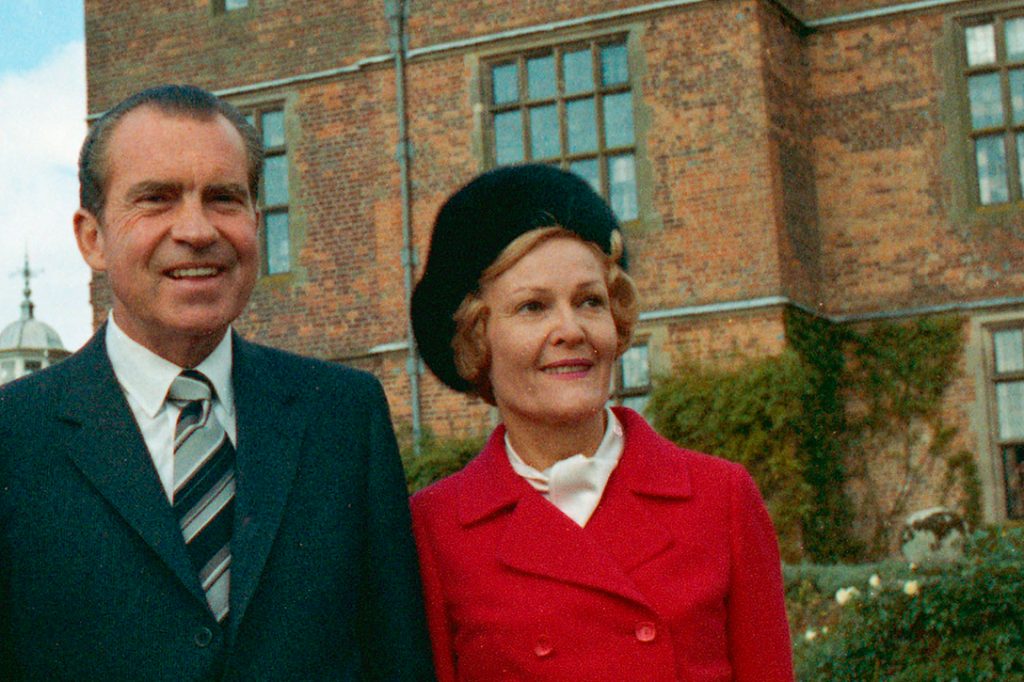
President Richard Nixon and Pat Nixon, October 3, 1970. Photo credit: The White House / Nixon Library
Even back in 1973, Gleason could come to only one conclusion. When special prosecutors in the Watergate investigation later grilled him about the Townhouse Operation, he told them as much. “The purpose of these contributions was to set up possible blackmail for these candidates later on.” However, at that point Gleason assumed that the sponsors of the blackmail were Nixon loyalists — perhaps even authorized by the president himself.
Alarmed at this arrangement, and cognizant that he might be generating myriad campaign law violations, Gleason asked the White House for a legal analysis. But despite multiple requests, he never got it. Finally, he asked for a letter stating that nothing he was being asked to do was illegal. (That letter, Gleason later explained, would somehow disappear before it could arrive at the offices of the Watergate prosecutors.)
Since the six-thousand-dollar donations were ostensibly generated by “Dick and Pat,” one could easily surmise that Richard Nixon, or those under his authority, were indeed out to get something on Republican candidates.
Once they took the cash, the recipients would have to do as he wanted, or else risk exposure. As Assistant Special Prosecutor Charles Ruff wrote to his boss: “It has been our guess that [the Nixon White House] hoped to gain some leverage over these candidates by placing cash in their hands which they might not report.”
Had this become known, Nixon would have had trouble explaining it. Few would have believed that such a scheme could have been run under White House auspices without Nixon’s approval. And yet that seems to have been the case. In fact, Nixon’s name rarely appears in the Townhouse files of Watergate prosecutors — for whom the evidence of Nixon’s wrongdoing would have been the ultimate prize.
Even the complex and calculating Charles Colson, who served as special counsel to the president in 1970, admitted to prosecutors that Nixon was not involved. Colson said that he had sat in on a Townhouse planning meeting and later briefed the president about “political prospects in that race” — but “did not recall that the fundraising aspects were discussed with the President.”
John Mitchell, who was attorney general before he resigned in 1972 to head up Nixon’s reelection campaign, attended a meeting for “substantial contributors” and later told prosecutors that “the President stopped by, but was not present during discussions of campaign finances.” Mitchell himself denied participation in or knowledge of the Townhouse plan. Even Herb Kalmbach, Nixon’s personal lawyer, seems to have been involved only in the most benign part of the operation: the legal solicitation of funds from wealthy donors. Of course, all this could be about denials and deniability — but as we shall see, it apparently was not.
Meet John Dean
.
At the time Townhouse was becoming operational, the position of counsel to the president opened up. John Ehrlichman, Nixon’s trusted aide, was moving to head up domestic affairs, and Ehrlichman was looking for someone to replace him — a smart lawyer and good detail man who was also loyal to the president. The man who came on board on July 27, 1970, was John Wesley Dean III.
Dean arrived at 1600 Pennsylvania Avenue just as President Nixon was trying to figure out how to deal with massive street demonstrations against the Vietnam War. A month before, a White House staffer named Tom Huston had drawn up a plan to spy on the demonstrators through electronic surveillance, recruitment of campus informants, and surreptitious entry into offices and meeting places.
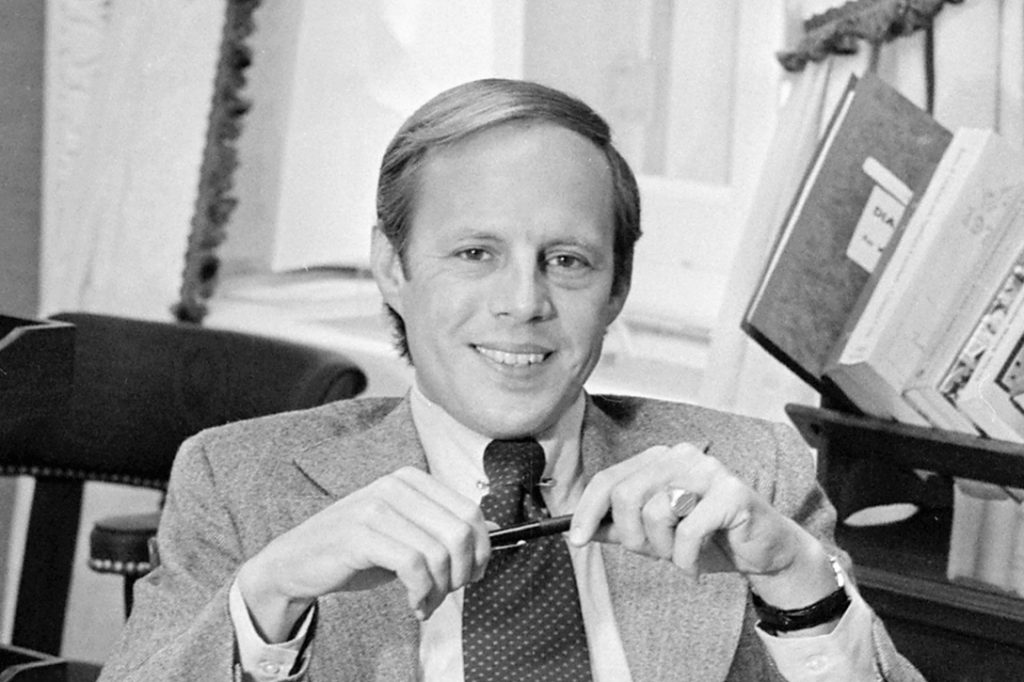
John Dean, counsel to the president, January 20, 1969. Photo credit: Richard Nixon Presidential Library / Wikimedia
In hindsight, this sounds especially odious, and it was, but at the time, and from the vantage point of the administration and its supporters in the “silent majority,” America was besieged. The general atmosphere in the country and the domestic violence, actual and hinted, surrounding the Vietnam War debate, felt like chaos was descending. Even so, Attorney General John Mitchell shot down the notorious “Huston Plan.” John Dean, however, took an immediate interest in some of the proposals.
Although his official duties centered on giving the president legal advice — often on arcane technical matters — Dean was considered a junior staffer and had virtually no contact with Nixon. Nevertheless, the White House neophyte quickly began taking on for himself the far edgier and dubious mantle of political intelligence guru.
Among the bits of intelligence Dean collected were the details of the Townhouse Operation. In November 1970, following the midterm elections, Jack Gleason turned over all his files to the White House, where
Haldeman had them delivered to Dean. Watergate investigators would later discover that “Haldeman also gave Dean several little notebooks which pertained to the 1970 fundraising.”
Those little notebooks would have told Dean who the donors were, how much they gave, and the identity of the recipients. Shortly after the files ended up in Dean’s hands, the media began receiving — perhaps coincidentally — leaks about the Townhouse Operation.
One of the first reports was an AP article with no byline that appeared in the New York Times on December 27, 1970. It said that seven ambassadors had received their positions as rewards for their contributions to the Townhouse Operation: “Mr. Jack Gleason left the staff of a White House political operative, Harry Dent, this fall to run the fund-raising campaign from a basement back office in a Washington townhouse.”
And there it was: Gleason caught up in something that sounded sinister, complete with the Townhouse basement back office, all purportedly on behalf of Richard Nixon.
In February 1972, someone cranked Townhouse back up again. Jim Polk, an investigative reporter at the Washington Star with an impressive track record on campaign finance matters, got more information about the fund from “inside sources.” Polk published an article headlined “Obscure Lawyer Raises Millions for Nixon.” It sounded even more disturbing than the previous one. Polk’s article did two things: It introduced the public to Nixon’s personal lawyer Kalmbach and it provided many new details about the Townhouse fund:.
A little-known lawyer in Newport Beach, Calif., has raised millions of dollars in campaign contributions as an unpublicized fund-raiser… [and] as Nixon’s personal agent… to collect campaign checks from Republican donors… Kalmbach helped to raise nearly $3 million in covert campaign money… The checks were sent through a townhouse basement used by former Nixon political aide Jack A. Gleason. But the operation was run from inside the White House by presidential assistant H.R. (Bob) Haldeman… Only a portion of this money has shown up on public records. The rest of the campaign checks have been funneled through dummy committees.
When I spoke to Polk in 2008, not surprisingly, he no longer recalled the identity of his source. But whoever had leaked this story to him was no friend of Nixon’s. Yet if it was intended to provoke further interest, it failed.
Someone had attempted to light a fuse with Townhouse, but it did not ignite. Just four months later, however, another fuse was lit. And this one would burn on and on.
The Brazen Burglary
.
If Townhouse was engineered to discredit Nixon, it had one potential flaw. The wrongdoing involved technical financial matters that reporters might find daunting. Watergate, on the other hand, was inherently sexy; it had all the elements of the crime drama it became. The break-in was brazen and easily grasped, and carried out in such a manner as to just about guarantee both failure and discovery. It also involved a cast of characters that neither reporters nor television cameras could resist (as the Watergate hearings later would demonstrate).
It was like a made-for-TV movie: Burglars in business suits, living in a fancy suite near the scene of the crime; Cuban expatriates; documents in pockets leading to the White House. Even Nixon had to interrupt his reelection campaign to confront it.
But the burglars didn’t appear to take anything, so what was the intended crime? Breaking and entering — for what purpose?
As with the JFK assassination, theories abound. The burglars were found with bugging equipment. But that made little sense; Nixon didn’t have much to worry about from his presumed Democratic opponent, George McGovern.
The risks of a bugging operation far outweighed any conceivable gains. And if Nixon had really wanted inside dope on the McGovern campaign, which he hardly needed, he could have sent teams into McGovern’s headquarters up on Capitol Hill, or to Miami, where the Democrats would hold their convention.
If, on the other hand, the intent was to fire the public imagination, the Watergate complex was far better — and Washington itself a necessary locale if the national press was to stay with the story week after week.
With all this in mind, Nixon’s observation in his memoirs that “the whole thing was so senseless and bungled that it almost looked like some kind of a setup” seems on the mark.
If the Cubans were really trying to do the job, their supervisors were guilty of malpractice. They might as well have called the D.C. police to reserve an interrogation room.
The flubs were so obvious it was as if they were the work of amateurs — which it was not. Burglary team member James McCord left tape horizontally over a lock, so that it could be spotted, as it was, by a security guard when the door was closed. If he had taped the lock vertically, it would have been invisible to a passerby. And if the intent was to pull off a real burglary, there was no need for tape anyway — as the burglars were already inside. Even so, after the security guard discovered and removed the tape, McCord put it right back.
The entire operation reflected poor judgment. An experienced burglar would have known not to carry any sort of identification, and certainly not identification that led back to the boss. How elementary is that?
Among the incriminating materials found on the Watergate burglars was a check with White House consultant E. Howard Hunt’s signature on it — and Hunt’s phone number at the White House, in addition to checks drawn on Mexican bank accounts.
Despite the obvious risks, the burglars were also instructed by Hunt to register at the Watergate Hotel, and to keep their room keys in their pockets during the mission. These keys led investigators straight back to an array of incriminating evidence, not the least damaging of which was a suitcase containing the burglars’ ID cards. Everything pointed back to CREEP, as the Committee to Re-Elect the President was known, and the White House.
The most interesting thing was that the materials identified the burglars as connected not just to the White House, but to the CIA as well. And not just to the CIA, but to a group within the CIA that had been active during the controversial period that included the Bay of Pigs invasion and the assassination of JFK.
Hunt, whose status in the CIA was described earlier, was a high-ranking (GS-15) officer and a member of the “Plumbers,” a White House special investigations unit ostensibly dedicated to stopping government leaks to the media.
As discussed in chapter 6, Hunt had been a key player in the coup in Guatemala and the Bay of Pigs invasion, in addition to working very closely with Allen Dulles himself. As noted previously, Dulles was in Dallas shortly before November 22.
And Hunt had been there on the very day of the assassination, according to an account confirmed in 1978 by James Angleton, the longtime CIA counterintelligence chief. Angleton, clearly concerned that investigations would uncover Hunt’s presence in Dallas anyway, went so far as to alert a reporter and a House Committee to Hunt’s being in the city that day, and then opined that Hunt had been involved in unauthorized activities while there: “Some very odd things were going on that were out of our control.”
Watergate burglar and electronic surveillance expert James McCord, like Hunt, had also been a GS-15 agent, serving for over a decade in the CIA’s Office of Security. Around the time of the Kennedy assassination, he began working with anti-Castro Cubans on a possible future invasion of the island.
Allen Dulles once introduced McCord to an Air Force colonel, saying, “This man is the best man we have.” Regarding Nixon, McCord dismissed him to a colleague as not a team player, not “one of us.”
In a long-standing tradition, both Hunt and McCord had officially “resigned” from the agency prior to the Watergate time frame. But their continued involvement in CIA-related cover operations suggested otherwise. Indeed, as noted earlier in the book, many figures, including Poppy Bush’s oil business colleague Thomas J. Devine, officially took retirement prior to participating in seemingly independent operations in which deniability was crucial.
Though Hunt claimed to have cut his CIA ties, he actually went out of his way to draw attention to those ties while working in the Nixon White House. He ostentatiously ordered a limousine to drive him from the White House out to CIA headquarters in Langley, Virginia. It was as though he was trying to broadcast the notion that Nixon was orking closely with the agency — with which, as we now know, the president was in reality battling.
After Hunt’s alleged retirement, he was employed at the Mullen Company, a public relations firm that served as a CIA cover. In a 1973 memo, Charles Colson recounted a meeting he’d just had with Senate Republican minority leader Howard Baker. Charles Colson wrote, “Baker said that the Mullen Company was a CIA front, that [Hunt’s] job with the Mullen Company was arranged by [CIA director] Helms personally.” Baker also informed Colson that, during Hunt’s time at the Mullen Company, his pay had been adjusted to the exact salary he would have been making had he stayed at the spy agency.
Eugenio Martinez, one of the anti-Castro Cuban burglars, was another CIA operative in the break-in crew. Indeed, he was the one member of the team who remained actively on the CIA payroll, filing regular reports on the activities of the team to his Miami case officer.
Then there was Bernard L. Barker, who first worked as an FBI informant before being turned over to the CIA during the run-up to the Bay of Pigs.
Frank Sturgis, too, had CIA connections. Martinez, Barker, and Sturgis had worked with Hunt and Mc-Cord on the Second Naval Guerrilla operation.
So Nixon, who had been trying to see the CIA’s file on the Bay of Pigs, was now staring at a burglary purportedly carried out in his name by veterans of the same “Bay of Pigs thing” with strong CIA ties. It was like a flashing billboard warning. CIA professionals, Cuban exiles, all tied to the events of 1961 through 1963, suddenly appearing in the limelight and tying themselves and their criminal activity to the president.
Related front page panorama photo credit: Adapted by WhoWhatWhy from Watergate (Indutiomarus / Wikimedia) and Richard and Pat Nixon (The White House / Wikimedia).
